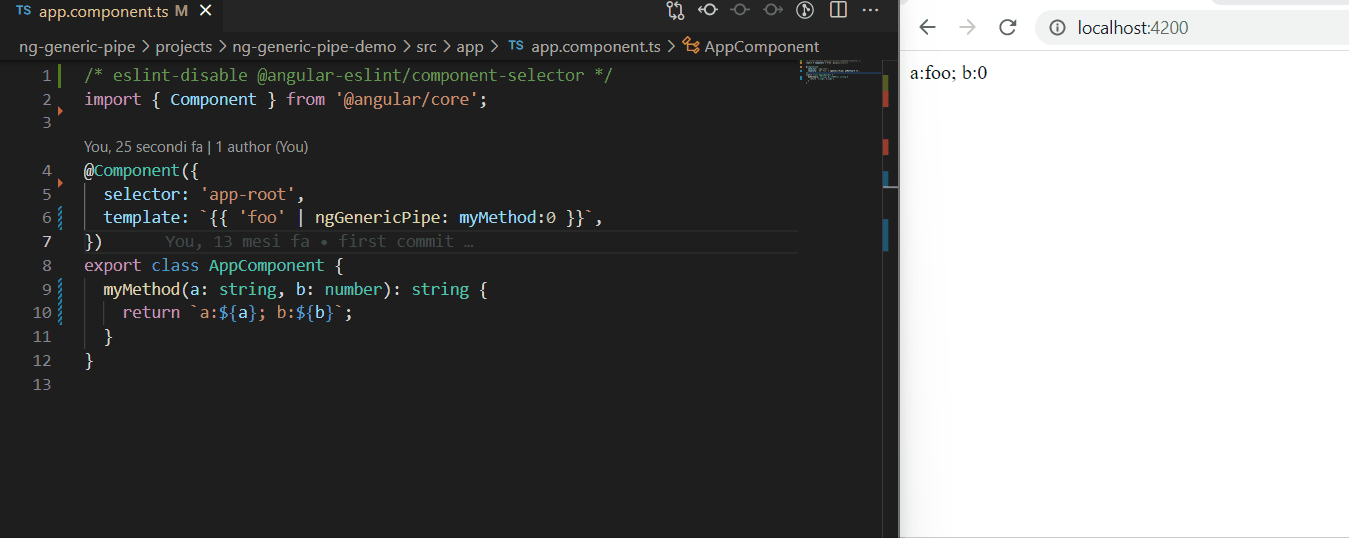NgGenericPipe 


Generic pipe for Angular application for use a component method into component template.
Description
Sometime there is a need to use a component method into component template. Angular best practice says do not use method into html template, eg. {{ myMethod(2) }}. With NgGenericPipe you can use all your public component methods as pure pipe with the component scope (this), eg: {{ 2 | ngGenericPipe: myMethod }}.
See the stackblitz demo.
Features
✅ More than 90% unit tested
✅ Use all your component methods as pure pipe with component scope
✅ Strong type check
✅ Only 658 byte (with gzip compression)
Get Started
Step 1: install ng-generic-pipe
npm i ng-generic-pipe
Step 2: Use ngGenericPipe into your HTML template, eg.:
import { Component } from '@angular/core';
import { NgGenericPipe } from 'ng-generic-pipe';
@Component({
selector: 'app-root',
template: `<div>{{ 'Simone' | ngGenericPipe: sayHello }}</div>`,
imports: [NgGenericPipe]
})
export class AppComponent {
sayHello(name: string): string {
return `Hello! I'm ${name}.`;
}
}
API
ngGenericPipe need to pipe on a value. The value become the first argument of the function called by ngGenericPipe, eg.:
'Hello world!' | ngGenericPipe: writeMessage
is translated into:
writeMessage('Hello world!')
You can pass, multiple parameter in this way, eg.:
'Hello world!' | ngGenericPipe: writeMessage:'Simone'
is translated into:
writeMessage('Hello world!', 'Simone')
and with more parameters, eg.:
'Hello world!' | ngGenericPipe: writeMessage:'Simone':'Foo':'Bar':'Baz'
is translated into:
writeMessage('Hello world!', 'Simone', 'Foo', 'Bar', 'Baz')
Because ngGenericPipe is a pure pipe, the method is memoized. This means that the pipe transform the html only if an argument change. You can force the change by passing and additional parameter that change when you need a repaint (see the example below "Call component method with component scope and force change detection
").
Strong type check
ngGenericPipe has strong type checking

Examples
Below there are some examples of use case.
Example: Call component method with component scope
You can call from template a component method test(x: number) and access to the component scope (this), eg.:
import { Component } from '@angular/core';
import { NgGenericPipe } from 'ng-generic-pipe';
@Component({
selector: 'app-root',
template: '<div>{{ 3 | ngGenericPipe: test }}</div>',
imports: [NgGenericPipe]
})
export class AppComponent {
public y: number = 2;
test(x: number): number {
return x * this.y;
}
}
Example: Call component method with component scope and multiple parameters
You can call from template a component method test(x: number, z: number) and access to the component scope (this), eg.:
import { Component } from '@angular/core';
import { NgGenericPipe } from 'ng-generic-pipe';
@Component({
selector: 'app-root',
template: '<div>{{ 3 | ngGenericPipe: test:3 }}</div>',
imports: [NgGenericPipe]
})
export class AppComponent {
public y: number = 2;
test(x: number, z: number): number {
return x * this.y * z;
}
}
Example: Call component method with component scope and no parameters
You can call from template a component method test() and access to the component scope (this), eg.:
import { Component } from '@angular/core';
import { NgGenericPipe } from 'ng-generic-pipe';
@Component({
selector: 'app-root',
template: '<div>{{ undefined | ngGenericPipe: test }}</div>',
imports: [NgGenericPipe]
})
export class AppComponent {
public y: number = 2;
test(): number {
return this.y;
}
}
Example: Call component method with component scope and force change detection
You can call from template a component method test() and access to the component scope (this), eg.:
import { Component } from '@angular/core';
import { NgGenericPipe } from 'ng-generic-pipe';
@Component({
selector: 'app-root',
template: `
<div>{{ undefined | ngGenericPipe: test:i }}</div>
<button (click)="onUpdate()">Update</button>`,
imports: [NgGenericPipe]
})
export class AppComponent {
public y: number = Date.now();
public i: number = 0;
test(): number {
return this.y;
}
onUpdate(){
this.i++;
}
}
Example: Call observable component's method
You can call from template a component's method testAsync() that return observable, eg.:
import { Component } from '@angular/core';
import { NgGenericPipe } from 'ng-generic-pipe';
@Component({
selector: 'app-root',
template: `<div>{{ 'hello!' | ngGenericPipe: testAsync | async }}</div>`,
imports: [NgGenericPipe]
})
export class AppComponent {
testAsync(value: string): Observable<string> {
return of(value);
}
}
Support
This is an open-source project. Star this repository, if you like it, or even donate. Thank you so much!
My other libraries
I have published some other Angular libraries, take a look:
- NgSimpleState: Simple state management in Angular with only Services and RxJS
- NgHttpCaching: Cache for HTTP requests in Angular application
- NgLet: Structural directive for sharing data as local variable into html component template
- NgForTrackByProperty: Angular global trackBy property directive with strict type checking


Programming Tips & Tricks
Code smarter, not harder—insider tips and tricks for developers.
#1
#2
#3
#4
#5
#6
#7
#8
#9
#10
Error Solutions
Turn frustration into progress—fix errors faster than ever.
#1
#2
#3
#4
#5
#6
#7
#8
#9
#10
Shortcuts
The art of speed—shortcuts to supercharge your workflow.
#1
#2
#3
#4
#5
#6
#7
#8
#9
#10
Made with ❤️
to provide resources in various ares.















